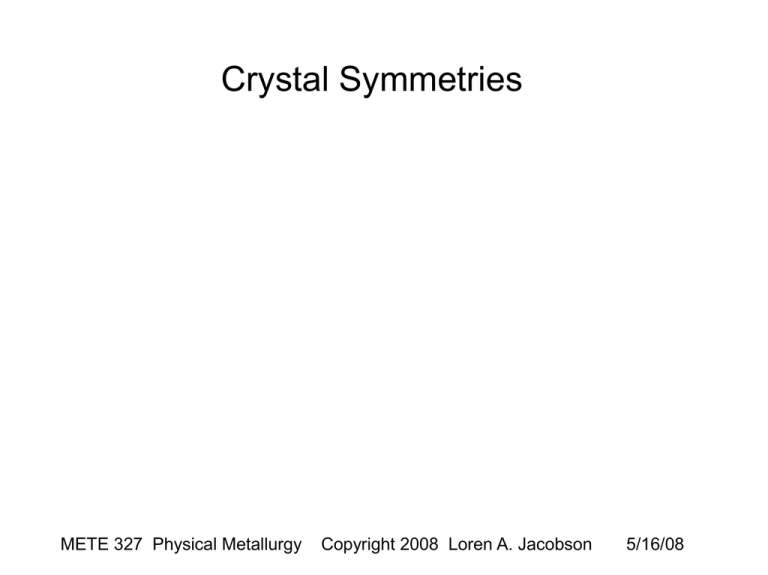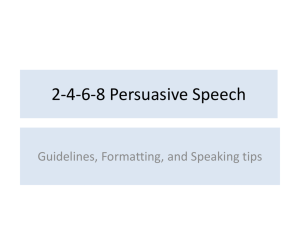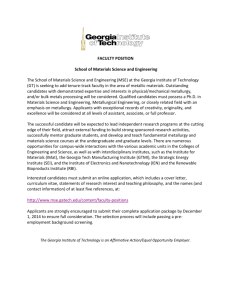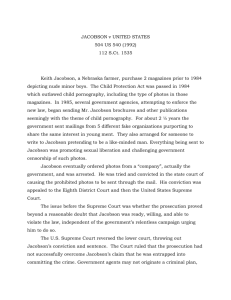Crystal Symmetries
advertisement

Crystal Symmetries
METE 327 Physical Metallurgy
Copyright 2008 Loren A. Jacobson
5/16/08
Why should we be interested?
●
●
Important physical properties depend on crystal
structure
–
Conductivity
–
Magnetic properties
–
Stiffness
–
Strength
These properties also often depend on crystal
orientation
METE 327 Physical Metallurgy
Copyright 2008 Loren A. Jacobson
5/16/08
Some Important Terms for Crystals
–
–
–
–
–
Crystal Structure
Bravais lattices
Symmetry operations
Basis of Close Packed
Structures
Miller Indices
●
●
–
Planes
Directions
Stereographic
Projection
METE 327 Physical Metallurgy
–
–
–
–
–
–
–
Standard Projection
Principal Metal Structures
—BCC, FCC, HCP
Ionic Crystals
Diamond Structure
Twinned Crystals
Isomorphism
Polymorphism
Copyright 2008 Loren A. Jacobson
5/16/08
Bravais Lattices (14 Total)
–
–
–
–
–
–
–
Cubic—a=b=c, all angles= 90o
Tetragonal—a=b /=c, all angles=90o
Orthorhombic—a/=b/=c, all angles=90o
Rhombohedral—a=b=c, three equal
angles, / =90o
Hexagonal—a=b/=c, two angles =90o ,
third =120o
Monoclinic—a/=b/=c, two angles =90o ,
third not.
Triclinic-- a/=b/=c, no angles =, nor =90o
METE 327 Physical Metallurgy
Copyright 2008 Loren A. Jacobson
5/16/08
Cubic Bravais Lattices
METE 327 Physical Metallurgy
Copyright 2008 Loren A. Jacobson
5/16/08
Tetragonal and Orthorhombic
METE 327 Physical Metallurgy
Copyright 2008 Loren A. Jacobson
5/16/08
Orthorhombic, Rhombohedral,
Hexagonal
METE 327 Physical Metallurgy
Copyright 2008 Loren A. Jacobson
5/16/08
Monoclinic, Triclinic
METE 327 Physical Metallurgy
Copyright 2008 Loren A. Jacobson
5/16/08
Miller Indices
–
A Convenient Way to Identify
Crystal Planes and Directions
●
●
For Planes, the index is the
reciprocal of the value of the
intersection of the plane with a
particular axis, converted to whole
numbers.
For Directions, the index is the axis
coordinate of the end point of the
vector,converted to nearest whole
numbers.
METE 327 Physical Metallurgy
Copyright 2008 Loren A. Jacobson
5/16/08
Miller Indices (directions)
–
–
–
h,k,and l refer to principal axes, x,y
and z.
Directions are indicated by square
brackets, [hkl]. Families of directions
are indicated by <hkl>.
Example of a family of directions:
<100> = [100], [010], [001], [-100],
[0-10] and [00-1]
● The first three are principal axes,
x,y, and z.
METE 327 Physical Metallurgy
Copyright 2008 Loren A. Jacobson
5/16/08
Miller Indices (planes)
–
–
Planes are indicated by
parentheses, (hkl) and families of
planes by curly brackets, {hkl}.
Example of a plane family is as
follows: {100} = (100), (010), (001),
(-100), (0-10), and (00-1)
● These are all six faces of a cube.
METE 327 Physical Metallurgy
Copyright 2008 Loren A. Jacobson
5/16/08
Calculating Miller Index for planes
z
y
x
Intercepts= 0.5, 1, 1/3
Intercepts= -1, 1, 0.5
Index = (213)
Index = (-112)
METE 327 Physical Metallurgy
Copyright 2008 Loren A. Jacobson
5/16/08
Calculating Miller Index, directions
End coordinates= 0.5,0.5,1
End=0,1,0.5
Index = [112]
Index=[021]
METE 327 Physical Metallurgy
Copyright 2008 Loren A. Jacobson
5/16/08
Hexagonal, Miller-Bravais Indices
c
Three a directions,
as shown, plus c
Indices are:
a3
a2
a1
(h,k,-(h+k), l)
The plane shown is:
(11-20)
METE 327 Physical Metallurgy
Copyright 2008 Loren A. Jacobson
5/16/08
Other Crystal Characterization
–
–
It is often important to determine crystal
orientation.
● Single crystals.
● Individual grains in a polycrystal
– If there is a preferred grain orientation,
this is referred to as “texture”.
One method is to employ the Stereographic
Projection.
METE 327 Physical Metallurgy
Copyright 2008 Loren A. Jacobson
5/16/08
Stereographic Projection
METE 327 Physical Metallurgy
Copyright 2008 Loren A. Jacobson
5/16/08
Some Cubic Crystal Planes
001 Plane
110 Plane
111 Plane
METE 327 Physical Metallurgy
Copyright 2008 Loren A. Jacobson
5/16/08
Crystal Symmetries
–
–
–
Translational Symmetry—a move of one cell
in each of 3 axis directions restores the
structure.
Rotational Symmetry—rotation of specific
angle (90o, 120o, 180o) restores the structure.
Mirror Symmetry—reflection across a plane
restores the structure.
METE 327 Physical Metallurgy
Copyright 2008 Loren A. Jacobson
5/16/08
A simple Cubic Structure
(illustrating translational symmetry)
The cubic unit cell
Eight unit cells, the start
of a crystal structure.
METE 327 Physical Metallurgy
Copyright 2008 Loren A. Jacobson
5/16/08
Rotational Symmetry, Cubic
Four-fold
Rotation
METE 327 Physical Metallurgy
Two-Fold
Rotation
Three-Fold
Rotation
Copyright 2008 Loren A. Jacobson
5/16/08
{100} Poles of a Cubic Crystal
METE 327 Physical Metallurgy
Copyright 2008 Loren A. Jacobson
5/16/08
Interplanar Angles
Points on the sphere are intersections
of plane normals.
METE 327 Physical Metallurgy
Copyright 2008 Loren A. Jacobson
5/16/08
Calculating Interplanar Angles
(Cubic Crystals)
Cos φ =
h1h2 + k1k2 + l1l2
-------------------------SQRT((h12 + k12 + l12 )(h22 + k22 + l22 ))
METE 327 Physical Metallurgy
Copyright 2008 Loren A. Jacobson
5/16/08
Calculating Interplanar Spacing
(Cubic Crystals)
1/d2 = (h2 + k2 + l2)/ a2
METE 327 Physical Metallurgy
Copyright 2008 Loren A. Jacobson
5/16/08
Standard (001) Cubic Projection
METE 327 Physical Metallurgy
Copyright 2008 Loren A. Jacobson
5/16/08
The Standard Stereographic Triangle
Useful for showing crystal axis orientations.
METE 327 Physical Metallurgy
Copyright 2008 Loren A. Jacobson
5/16/08
Metallic Bonding
–
Valence, or outer electrons of metallic atoms are distributed throughout
the structure. Positively charged metal ions are distributed within this
“sea” of electrons.
–
This allows metals to be electrical conductors.
–
There are second nearest neighbor interactions that influence the
crystal structure
METE 327 Physical Metallurgy
Copyright 2008 Loren A. Jacobson
5/16/08
Body Centered Cubic (BCC) Metals
α-Fe, Cr,
Mo, V, β-Ti,
β-Zr
METE 327 Physical Metallurgy
Copyright 2008 Loren A. Jacobson
5/16/08
Face-Centered Cubic (FCC) Metals
Cu, Al, Ni, Pb,
γ-Fe
METE 327 Physical Metallurgy
Copyright 2008 Loren A. Jacobson
5/16/08
Hexagonal Close-Packed (HCP)
Metals
Be, Mg, Zn, Cd, α-Ti, α-Zr
METE 327 Physical Metallurgy
Copyright 2008 Loren A. Jacobson
5/16/08
Relation Between FCC and HCP
A
B
C
A
B
C
.
.
.
METE 327 Physical Metallurgy
A
B
A
B
A
B
.
.
.
Copyright 2008 Loren A. Jacobson
5/16/08
BCC to HCP Transformation
Close Packed BCC plane {110} becomes
Close Packed HCP plane (0002).
METE 327 Physical Metallurgy
Copyright 2008 Loren A. Jacobson
5/16/08
BCC to HCP Transformation (2)
1.633
a
1.732 a
1.155 a
BCC {110}
a
HCP (0002)
In both cases the diagonal, where
atoms touch, is of length = 2a, where
a is the atom diameter. A small
distortion is needed for BCC to
transform to HCP. (Note that there
can be 6 orientation variants of HCP.)
METE 327 Physical Metallurgy
Copyright 2008 Loren A. Jacobson
5/16/08
Types of Transformations
–
–
–
Displacive, which means that atoms do
not have to move very far, and often a
shear displacement can lead from one
crystal structure to another.
Replacive, which means that atoms will
move some distance, to their new
locations and so longer range diffusion
is required.
These topics will be treated in more
detail later
METE 327 Physical Metallurgy
Copyright 2008 Loren A. Jacobson
5/16/08
Vector Multiplication Examples
c=axb
b
b
α
α
a
a
a
c= a x b
b = ab cos a
c = ab sin a
b 3 = a1 x a2
a3 ( a1 x a2)
b3
a3
a2
a1
METE 327 Physical Metallurgy
Copyright 2008 Loren A. Jacobson
5/16/08
METE 327 Physical Metallurgy
Copyright 2008 Loren A. Jacobson
5/16/08
METE 327 Physical Metallurgy
Copyright 2008 Loren A. Jacobson
5/16/08





